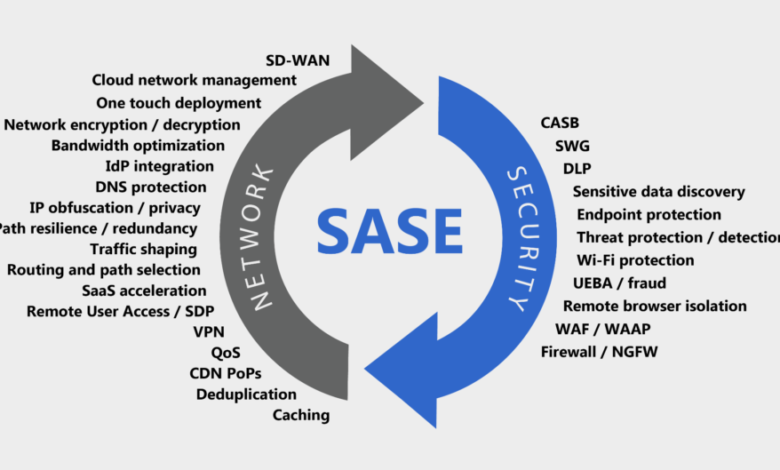Understanding Secure Access Service Edge (SASE)

SASE is a growing network and security platform that converges SD-WAN and network security point solutions (Firewall as a Service, Cloud Access Security Broker, Secure Web Gateway, and Zero Trust Network Access) into a single, cloud-native service.
Having people, devices, and data virtually everywhere means organizations must be able to secure all of it quickly and efficiently. It requires a change in the traditional security architecture.
What is SASE?
SASE combines cloud networking with security to provide ease of use, scalability, flexibility, and all-encompassing security. Secure access service edge definition (SASE) offers fast access to appropriate applications and data from any user or device, regardless of location.
IT teams today are faced with an accelerated shift to a distributed workforce. They need an architecture capable of identifying users and devices, applying policy-based security controls, and delivering secure access from any location. Traditional network security needs help to meet the needs of this new work model.
As a result, traditional firewalls and other point solutions aren’t equipped to handle this type of environment. SASE is a unique model that combines network security functions like DLP, decryption at line speed, and threat intelligence with network services, including VPN replacement, content delivery networks (CDNs), cloud access security brokers (CASBs), and edge networking.
The key to SASE is a cloud-native, cloud-delivered architecture that uses key cloud capabilities like elasticity, adaptability, and self-healing to deliver the best possible experience for business users and applications. It also offers a single management platform that provides centralized policy enforcement while keeping policies local to the user, device, or application. It makes SASE a more flexible, easy-to-deploy, and maintain security solution that meets the needs of a digitally native workforce. It is especially true for enterprises with a diverse workforce across locations and different types of devices, such as mobile and IoT.
Why is SASE Important?
With business operations moving from brick-and-mortar locations with local data centers to distributed hybrid workforces that are increasingly mobile and remote, traditional network security is struggling to meet the needs of these users. It points out that this can lead to many challenges, including complex management of technologies, too much work for the staff, inadequate protection from cyberattacks, high latency, and increased costs.
SASE unifies networking and security services in a cloud architecture model that can help organizations address these challenges. This model enables enterprises to take advantage of firewall-as-a-service (FWaaS), secure web gateway (SWG), zero-trust network access (ZTNA), and other threat detection functions that can be implemented at the edge for use independent of location.
Using a combination of identity-based security, policy, and enforcement, SASE ensures that all connections are inspected and secured, regardless of where they originate or what application they connect to. It helps prevent the lateral movement of an attacker who compromises the network perimeter through a VPN connection and protects against malware attacks, data exfiltration, and other threats.
SASE also offers several other benefits, including lowering cost and complexity, enabling ZTNA, reducing the number of agents needed for branch offices, and providing a consistent applicate experience on any device. In addition, SASE can also help to improve user productivity by enhancing the ability to monitor apps, devices, and network performance in real-time.
What are the Benefits of SASE?
SASE enables a more secure, efficient way to deliver network services and access to apps and data. Today’s mobile workforce needs fast, reliable access to corporate business applications and data when they’re on the go. Businesses must enable this new normal while maintaining security at the same time.
Traditional networking models require users, devices, and applications to pass through a network perimeter to access data in a core data center. It could be more efficient and can cause significant performance issues.
To overcome this, SASE architecture combines networking and security functions to create a unified cloud-native architecture delivering typical cloud benefits like scalability, flexibility, agility, global reach, and delegated management.
By unifying networking and security, SASE reduces operational complexity for IT teams and helps them focus on more strategic activities such as monitoring performance, detecting threats, and resolving security incidents. It also increases efficiency because it removes the need to manage multiple tools.
With a SASE framework, IT leaders can set policies centrally via cloud-based management platforms and enforce them at distributed PoPs close to ending users. It makes it easier to implement Zero Trust Network Access (ZTNA) approaches, which control network access based on user, device, and application identity, not location and IP address.
SASE also enables the integration of advanced threat prevention and full content inspection, reassuring that the data is protected. It can also provide centralized policy enforcement, allowing managers to track access requests and enforce security policies across the cloud and network simultaneously.
How Does SASE Work?
In today’s digital enterprise, more data, users, devices, applications, and services are being accessed outside the traditional corporate perimeter. It creates a need for an entirely new network approach to provide security to distributed business operations.
SASE is an identity-based, zero-trust access architecture that enables organizations to control access to critical applications and resources across the edge network while eliminating the need for cumbersome VPNs. It combines various network and security functions, including secure web gateway (SWG), cloud access security broker (CASB), firewall-as-a-service (FWaaS), and zero trust network access (ZTNA).
The SASE model enables enterprises to easily apply consistent security policies to all their environments without using multiple disparate centralized management platforms. It provides real-time visibility into all endpoints connecting to the network and can identify if they have access to sensitive or insecure data or services.
To ensure the network is fast and reliable, SASE uses latency-optimized routing to send traffic to a local enforcement point that processes it most efficiently. It reduces latency, increases performance, and delivers an exceptional user experience.
As the mobile workforce continues to grow, IT needs to be able to manage access and wireless performance to these users no matter where they are. SASE gives IT the scalability and security required to support this growing workforce.





